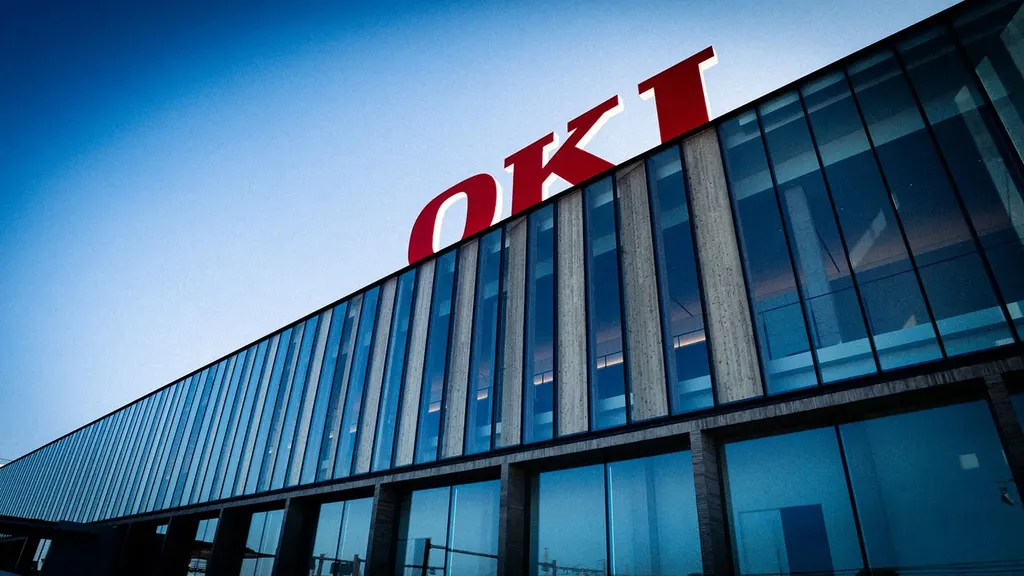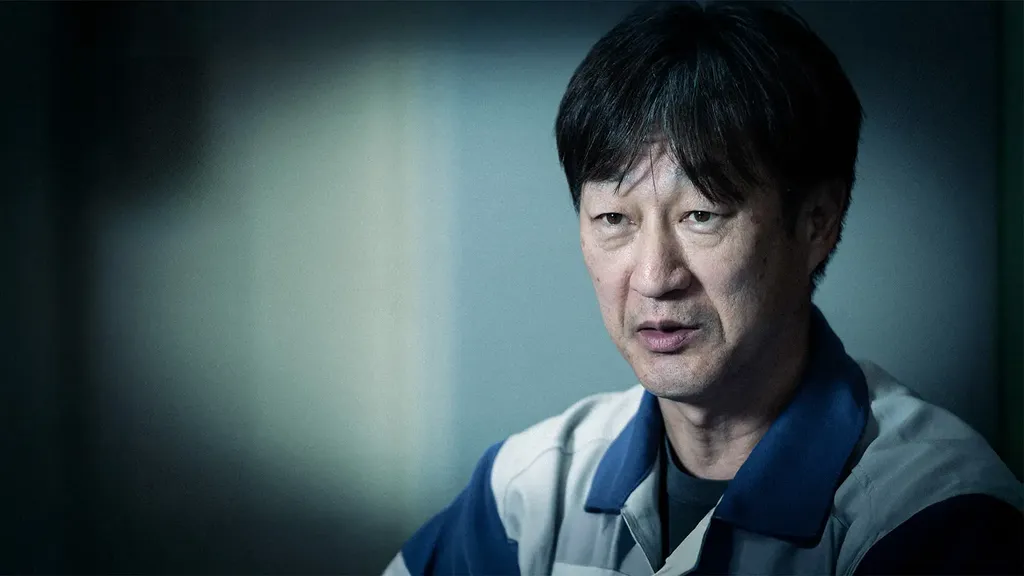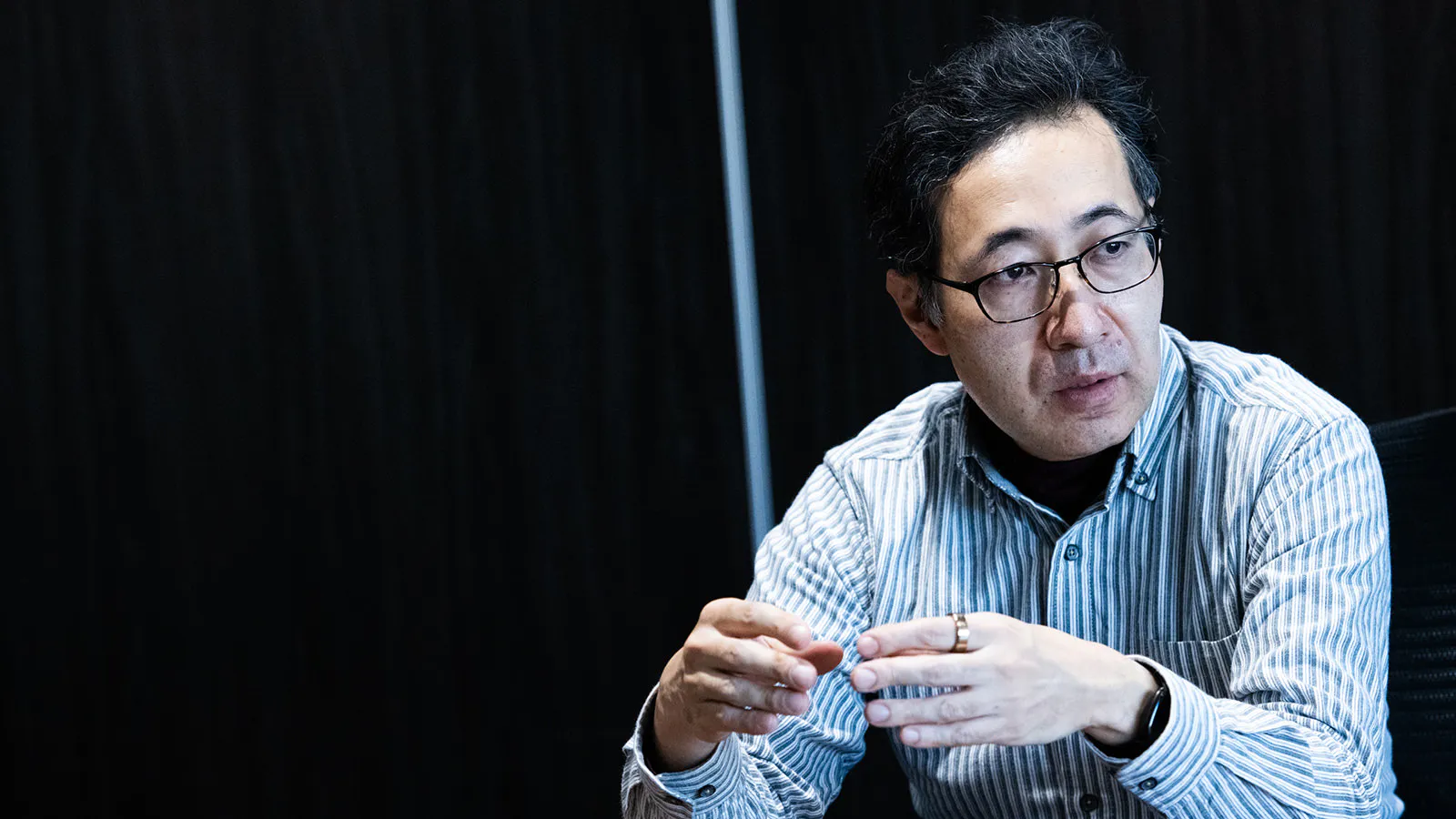
Energy and Digital Infrastructure Convergence Leads to Solutions to Energy Challenges
Hiroshi Okamoto (Tokyo Electric Power Grid)
-XGMF Millimeter Wave Dissemination Promotion Workshop / Japan's Industrial Technology Frontline Report
The 5th Generation Mobile Promotion Forum (5GMF, now the XG Mobile Promotion Forum (XGMF)) held its fourth workshop on the "Industrial Technology Frontiers in Japan" to promote millimeter wave dissemination in March 2024. The aim was to have a forum to interact with people outside of the broad telecommunications industry, and the 4th...
2024/05/09
Posted on 2024/05/09
The 5th Generation Mobile Promotion Forum (5GMF, now the XG Mobile Promotion Forum (XGMF)) held the fourth session of its millimeter wave dissemination promotion workshop "Japan's Industrial Technology Frontiers" in March 2024. The aim was to have a forum to interact with a wide range of people outside the telecommunications industry, and TEPCO Power Grid from the electric power industry took the stage at the fourth session. The theme was "What is the fusion of energy x digital x mobility toward the realization of Utility 3.0 = Human-centered Industrial Revolution. Hiroshi Okamoto, Executive Vice President and CTO of TEPCO Power Grid, and Masahiro Tanaka, Business Development Office and Corporate Planning Office of TEPCO Power Grid, spoke at the event. The full report is based on Mr. Okamoto's speech.
The energy sector is undergoing a period of great change. I believe that it will be further integrated with telecommunications and digital technologies. I would like to explain the idea of "human-centered industrial revolution" in reference to homeostasis in the human body, or the complementary relationship between nerves and blood vessels, which is at the core of Utility 3.0. I would like to explain the idea of a "human-centered industrial revolution" with reference to the complementary relationship between nerves and blood vessels.
First, let me introduce the inseparable relationship between the energy transition and the Industrial Revolution. The steam engine led to the first industrial revolution, and before the second industrial revolution, factories had large steam engines that transmitted power mechanically. On the other hand, if you look at the picture of Ford's car factory, where electricity was used in the second industrial revolution, it is very clear. By using electricity to run many motors, the layout of conveyor belts became more flexible and the factory became more productive. Mass production became possible.
In the human body, a network is needed to deliver oxygen to the muscles. If we compare factories to the human body, muscles are equivalent to motors. To run a motor, a network that delivers electricity is necessary, so it can be thought of as being similar to blood vessels in the human body. In this light, we can think of the Second Industrial Revolution as the introduction of electricity into society like blood vessels, and the Third Industrial Revolution as the introduction of communications for information processing like nerves.
Mobility, robots, and drones are key to demand adjustment
Let's move on to power. We may be concerned about the lack of electricity. On snowy winter days, a very large amount of electricity is used. On the other hand, during the Golden Week holidays in the spring, we use less electricity, about half of what we use in the winter.
When winter usage is high, most thermal power plants in the Kanto region are operated and electricity is supplied from facilities throughout Japan. In addition, we manage to keep up with hydroelectric power generation called pumped-storage power generation. Pumped storage power generation is hydropower generation with an upper pond and a lower pond. Water from the lower pond is pumped into the upper pond and released into the lower pond when needed to generate hydropower. It works like a giant battery because it uses electricity to pump up the water and then releases it to extract power.
On a winter day, the battery has gone from 100% fully charged in the morning to less than 20% or so at night. If the water runs out and the batteries run out, about 10 million kilowatts or so of the maximum supply of about 53 million kilowatts will be gone. Conversely, during the Golden Week holiday, the minimum amount of electricity generated by thermal power plants plus solar power would exceed demand. The excess there is adjusted by storing it in the pumped storage batteries. The system alternates between a shortage of electricity in winter and summer and a surplus in spring and fall.
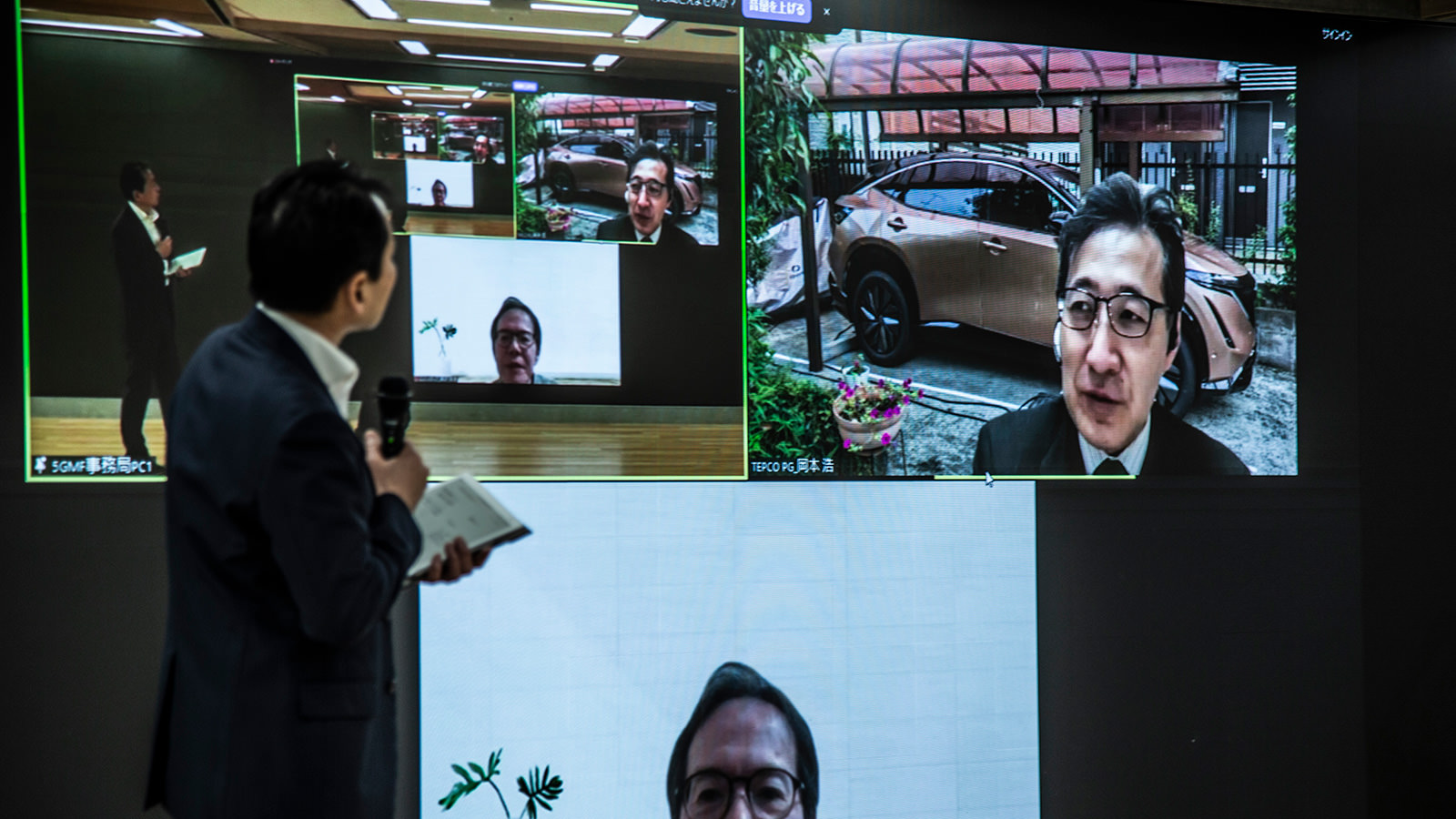
In terms of the supply and demand of electricity, until now electricity production has been adjusted to match consumption. However, if offshore wind power is increased in addition to solar power, production itself will fluctuate. This requires a reversal of the concept of matching consumption to production.
Some may say, "You can't do that," but new machines such as mobility vehicles, robots, and drones are equipped with batteries, making it possible to adjust supply and demand. The "Eco-Cute," an electric water heater that uses heat pump technology to heat water with the heat of the air, can also store energy as warmth in a hot water tank. In this way, many of the demands that will emerge in the future will be adjustable. If we can create controllable demand, we believe we can align production and consumption by promoting behavioral change through price signals and other means. Machines, devices, and services that act as a bridge between the user experience and the power supply will automatically adjust supply and demand in the future. Not only will they not compromise comfort, but conversely, they will both increase comfort through automation and expand the ability to adjust supply and demand.
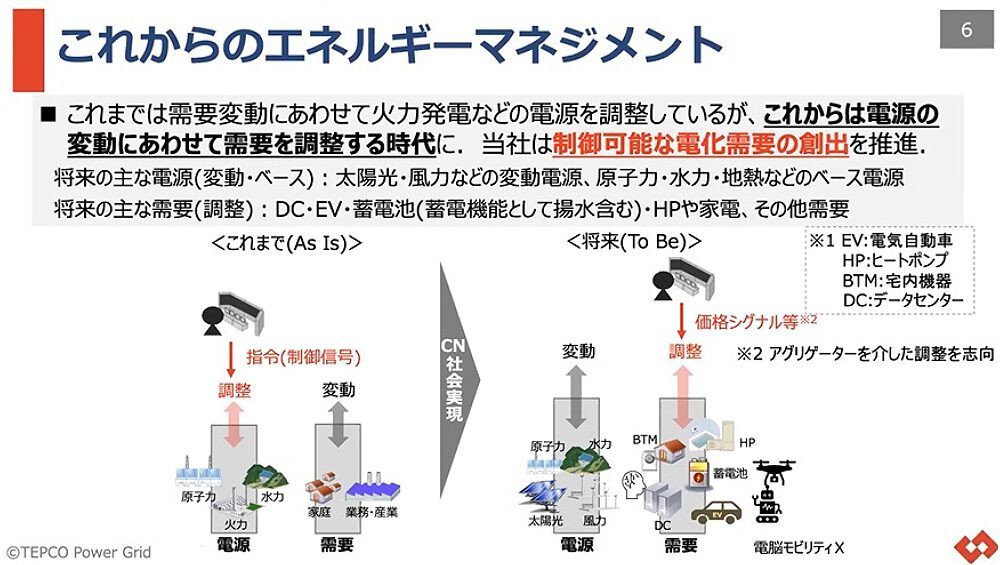
Earlier, I likened the electrical network to the blood vessels of society and the digital infrastructure to the nerves. In living organisms, blood vessels and nerves are actually located very close to each other. It is becoming clear that they signal to each other and maintain a mutually complementary relationship. If we translate this into today's world, we can come up with the idea that the digital infrastructure, which is the nerves, and the electricity grid, which is the blood vessels, should be more closely aligned and make better use of their complementary relationship.
Coordination of supply and demand by linking power and information
Three case studies will be presented on the complementary relationship between digital infrastructure and the electric grid.
One is data centers, which consume large amounts of electricity. Consumption is expected to increase by about 6 million kilowatts over the next five years. Since the maximum demand of the Tokyo Electric Power Company Power Grid is just under 60 million kilowatts, this means that demand will increase by more than 10% relative to the maximum demand. The idea is that this data center will help adjust supply and demand.
Suppose there is an island rich in renewable energy and a city that uses information. If the data center is located in the city that uses the information, the method that comes to mind is to send electric power from the island via power cables. However, power cables are very thick, heavy, and costly and time-consuming to install. On the other hand, the communication infrastructure is laid with optical fiber, which is overwhelmingly lighter, thinner, and less expensive than power cables. The difference in installation cost is about 100 to 1. In other words, a data center can be built on an island where renewable energy is abundant, and information can be exchanged with the city via optical fiber. This is a typical example of the strong mutual exchange relationship between electric power and digital infrastructure.
The next topic is related to 5G and wireless networks. This is an image of using a TEPCO Power Grid substation as a local data center. The substations are connected to local renewable energy sources, and this is a way to locally produce and consume renewable energy by placing an edge server here. By mounting a baseband unit (BBU) of a base station such as 5G on this edge server, the basic structure of a base station is created at the substation. From here, if we extend optical fiber, prepare a power supply, and connect it to the antenna, we can create a 5G network. In our company alone, there are 6 million utility poles that can be connected to the 5G network, and we can also use railroads and other facilities. In order to enable 5G signals to be transmitted over a wide area, we can use substations and utility poles in a variety of ways.
The third is the complementary relationship between cloud workload shifts and electricity. Suppose there are two areas, Area A and Area B, and it starts raining in Area A and solar power generation is decreasing. At that time, it is difficult to suddenly reduce the power demand in Area A, but it is possible to move the compute load from the servers in Area A to the servers in Area B instantly. If Area B is sunny and has sufficient solar power generation, the supply-demand relationship can be shifted by moving the computation load.
Workload shift is actually a very flexible demand from those of us in power energy, where the location of power consumption suddenly moves from A to B at a moment's notice throughout the space. Not only can we shift space between data centers, but we expect to shift time as well. That is, we want AI learning to proceed when there is a surplus of power in the spring and fall, and to be held back when there is a shortage in the summer and winter, etc. The workload is not only directed to the servers in the data center, but also to EVs and other vehicles and robots. The idea is to have the computers in the cars and robots perform AI and other calculations when they are not running.
The Day the Power Infrastructure Becomes an Intelligence Network
These will be adjusted through energy management. The electricity from renewable energy sources is not very flexible, but the idea is that society will reverse this trend and become more and more flexible, so that the two will be well matched.
There are three layers in energy management: the layer of the various machines that operate in your home or factory, the layer of the power company, and the middle layer that coordinates them. The middle layer is also an important part of the system, and I believe that a distributed energy trading market is needed in the region. The local distributed energy trading market will play an important role in connecting both customers and the national power companies.
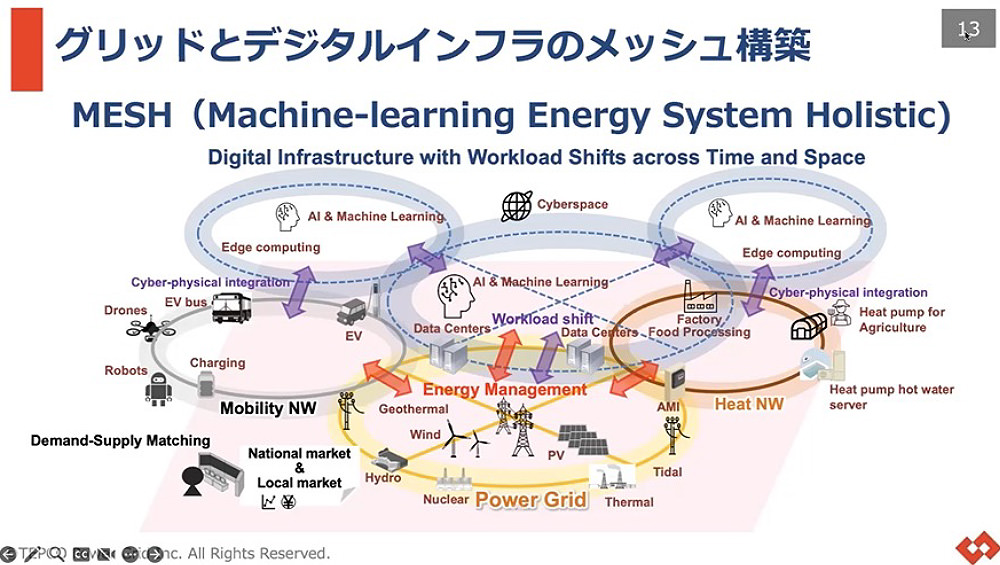
When all three layers are connected, price signals by location and time will be sent out over a nationwide network, triggering behavioral change in response to price signals. Another important factor will be the carbon footprint of CO2 as well as price, since it is necessary to consider running electricity with low CO2 emissions, so signals of price information plus CO2 information will be traded as important information, and the energy management system will move accordingly. We believe that the energy management system will respond to these signals.
In other words, the future of energy management will have intelligence end-to-end, from the customer to the middle layer to the power company. This is very similar to the Internet. If such an intelligence network can be extended not only in Japan but also globally, a shift in place and time through energy management can be realized worldwide. I believe that Japan can function as a gateway for this.

Hiroshi Okamoto
Director, Executive Vice President, Chief Technology Officer (CTO), Tokyo Electric Power Grid Co.
He has served in his current position since 2017 after serving as Director of the Engineering Research Group and Planning Department of the Head Office Engineering Department, Head Office Power Grid Company, General Manager of the Grid Wide-Area Interconnection Promotion Office, Engineering Management Department, and Corporate Planning Division of the Tokyo Electric Power Company, Incorporated, and as Managing Executive Officer of the Tokyo Electric Power Holdings, Incorporated.


